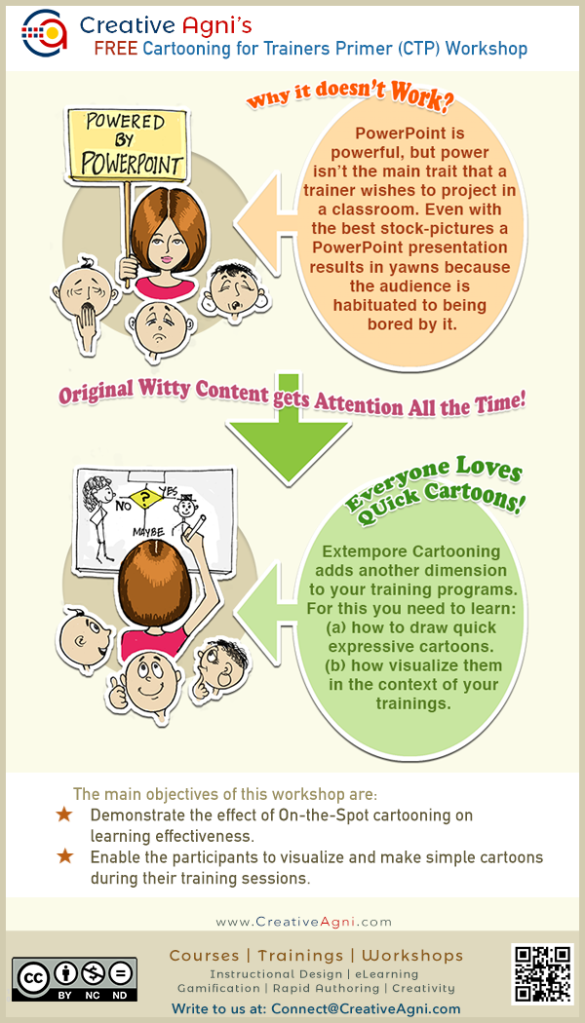Note: This is the second post in the sequence, “The Advantages of eLearning.” Please read the first post here.)
In “The Advantages of eLearning (1 of 2)”, we reflected upon the advantages, real and apparent, that accrue to the client organization and the audience. We also spoke about some of these advantages not being real, and gave them the somewhat exotic name – The Doppelganger Advantages. (As the ID-aware readers must’ve already surmised, the nomenclature served the purposes of curiosity arousal, one of the three ARCS techniques to Gain Attention (Refer: Keller’s ARCS Model.)
(Doppelganger – a ghostly double of a living person that haunts its living counterpart – Source: The Free Dictionary) (Simply said, you think that you are looking at someone, but that someone isn’t real!)
Here are our three Doppelganger advantages once again. Let us now remove them from the “Advantages” class, and shift them to the “Characteristics” class, as their status as an advantage is being questioned through this post.
Following are the Characteristics of eLearning, which have been touted as advantages by some.
- Create Once and Integrate according to the Requirements (The client’s perspective.)
- Cost Reduction of Different Kinds (The client’s perspective.)
- Offer Flexibility and are Easy to Complete (The audience’s perspective.)
Let us analyze each of these once again, but now let us look at the overall impact (the long-term impact on the client-audience duo) of these characteristics, instead of looking at only one part of the picture.
Create Once and Integrate as per Requirements:
This is one of biggest selling point of eLearning. Unfortunately, when reusability is stretched to a point where the content turns so brittle that it can barely be kneaded to impart digestible learning, the learners shut their minds off and stop learning. Organizations often remain blissfully (and sometimes, deliberately) ignorant of the fact that the sharable learning objects created by them fail to attract the audience’s attention completely. This aborted attempt at learning is often clocked as valid learning hours – and the organization has a “trained” employee who doesn’t have the competencies that his role requires!
If we stay true to instructional design, we’ll realize that a blinding passion for sharability doesn’t work! Unfortunately customized eLearning is expensive to develop. According to instructional design, it is that audience-mapped customized eLearning that would work best! However, the decision-makers in the client-organizations are human too – they need to see the impact of their decisions on the annual results – and so the long-term impact of such content doesn’t connect with their schema.
So the question is – who’s the ultimate loser?
While you try to answer that question, let us see the impact of the different kinds of cost-reduction!
Cost Reduction of Different Kinds:
We know that organizations are happy to cut their costs, which of course is a noble objective. We spoke of some costs that organizations expect to reduce through the implementation of eLearning. They expect to have a reduced number of onground trainings, which would result in the reduction of
- Trainer Costs
- Logistics Management Costs
- Opportunity Cost (working hours lost in classroom trainings.)
Now let’s quickly look at the eLearning implementation costs. There are the technology costs (procurement and implementation,) the content costs (if the content has to bought/extracted from the Subject Matter Experts,) the development costs, the facilitation costs, and the management costs! I may have even missed some. Think about it – eLearning implementations aren’t cost-free.
Remember, in the short-run, eLearning is more expensive that classroom training; and if eLearning content is created without considering the audience, it may turn out to be more expensive in the long-run too.
Flexibility in Submission Deadlines and are Easier to Complete:
Often the audience assumes that online/eLearning courses are self-study courses, and that the only commitment required from their end is to spend x number of hours a week on the course. This perception has its roots in two different realities.
- There are online courses that work on this premise – they provide the content, allow the learner to ask questions if he or she wants to, make provisions for an online objective test, allow the learner y number of attempts at the test (to ensure that he or she passes), and finally, generate a printable certificate by running a program, which the learner can print and file away. Course ends – competency achieved at BL2 (if at all!)
- The adult learner’s exaggerated application orientation coupled with the belief that concepts don’t matter, only application does, is the second reason behind this incorrect perception! So the adult learner often assumes – If I can take a course – find what I need to apply now and skip the rest – I am done!
The truth is the opposite of this. Online courses can be great learning experiences, if the above two realities don’t exist. The learning provider and the learner, both have to share the responsibility of making the experience successful. The learning provider has to ensure that the learner learns. The learner has to realize that the online courses require the participants to be internally motivated, organized, and punctual. The instructionally sound online courses require a lot more from its learners than a classroom training program.
End Note:
eLearning can result in a win-win relationship between the client organization and the audience, if it is designed, developed, and implemented according to instructional design principles. A departure from the ID principles on any pretext can reduce the learner’s motivation levels, and can lead to the failure of the learning experience.
(Short Link to this Post: http://wp.me/pFZ5p-3N)




